Download 5U Oakley Modular Series Voltage Controlled Oscillator User Manual
Transcript
5U Oakley Modular Series Voltage Controlled Oscillator The 'one of three' VCO module User Manual V6.0.5 Tony Allgood B.Eng PGCE Oakley Sound Systems CARLISLE United Kingdom Introduction This is the User Manual for the issue 5 and issue 6 VCO 5U module from Oakley Sound. This document contains an overview of the operation of the unit, the history of the various board issues, and all the calibration procedures. For the Builder's Guide which contains information on how to construct the module from our PCB and parts kits please visit the main project webpage at: http://www.oakleysound.com/vco.htm For general information regarding where to get parts and suggested part numbers please see our useful Parts Guide at the project webpage or http://www.oakleysound.com/parts.pdf. For general information on how to build our modules, including circuit board population, mounting front panel components and making up board interconnects please see our generic Construction Guide at the project webpage or http://www.oakleysound.com/construct.pdf. The Oakley 'One of three' VCO Module The Oakley ‘One of Three’ is a voltage controlled oscillator module that was inspired in part by the VCO design of the later MiniMoogs. In this module I decided to create a VCO that sounded good and performed well enough to keep up with the digital oscillators of modern day synthesisers. The VCO features sawtooth, pulse, triangle and a low distortion sine output. The duty cycle of the pulse output may be controlled directly by a PCB mounted pot, and also an external voltage, the sensitivity being controlled by another PCB mounted pot. The frequency of the VCO can be controlled by two PCB mounted pots, one for fine, the other for coarse adjustment. These four pots are designed to be fitted to the main board, and when special pot brackets are used, the PCB can be firmly supported to the front panel. The output levels for the sawtooth, sine and triangle are standardised at +/-5V, ie. 10V peak to peak. The pulse wave output is also 10V peak to peak, but the peak levels vary with pulse width. The Oakley VCO uses an interesting technique to maintain the average voltage over one cycle to zero volts. This new circuit essentially adds an offset to the pulse output to compensate for the non zero average voltage for any pulse wave that isn't a square wave. Ordinarily, one would see average DC values varying from +5V to -5V as the PW is swept from one end to the other. In the new VCO, this average level is kept at zero. This means that for narrow pulses, you now have a wave that goes from just below 0V [down] to just below +10V [up]. For square waves, you have the usual +5V up and -5V down. For wide pulses, you have a wave that is just below 0V [up] and just below -10V [down]. The reason for this is that fast pulse width modulation no longer adds thumping to the audio output. ie. fast EG sweeps of PW will sound great. All outputs have an output impedance of roughly 1K. The pulse output is also switchable between ‘centre modulated’ and ‘edge modulated’ forms of pulse width modulation. Most VCOs will only offer edge modulated, in which only one edge of the pulse wave is affected by the pulse width pot or modulating CV. The Oakley VCO allows you to modulate either one edge (edge) or both (centre). In fixed pulse width applications this generally makes no audible difference. However, when used with fast moving modulating CVs the difference in timbre is apparent. A high impedance synchronisation input is provided to prematurely reset the VCO waveform. With this you can force the VCO’s operating frequency to that of an external sawtooth signal, say from another VCO module. This input is level sensitive, so hard sync is possible with inputs of about +3V or above. Inputs below this will cause only occasional synchronisation leading to interesting harmonic structures. Please note; that to cause hard sync effects the master ‘sync’ signal must be a sawtooth (falling ramp shape) waveform of 10V peak to peak. The slave VCO will not sync to a ramp waveform which typically has a rising ramp and does not feature the fast rising edge the VCO needs to lock on to. These ramp waveforms are, in my opinion, erroneously called sawtooth by some manufacturers. However, a simple inverting circuit will be sufficient to turn the waveform around the right way so it can be used as a sync master. The VCO supports the standard 1.00V/octave exponential voltage to frequency relationship. However, a linear control input is also provided for constant depth frequency modulation. Temperature compensation is performed by using a matched transistor pair in the exponential convertor, and a high quality temperature sensitive resistor. The Oakley CV/gate Buss You really should think about using the Oakley Buss if you have a medium sized Oakley system. Using the Oakley Dizzy board it allows the 'keyboard control voltage' (KCV) and Gate signals to be piped around the back of the modular’s case along with the power supply rails. Any VCO and VCF can be connected to the Oakley Buss's KCV line, and this will save you having to patch KCV to every module that needs it. Inserting any patch lead into the 1V/OCT socket will override the CV bus line connection. The gate signals are treated similarly to the KCV line but for use with the ADSRs and other envelope generator modules. The Oakley CV/gate buss uses a common three way 0.1” Molex KK header to carry the two signal lines around your modular. A third, as yet unused connection is also present for future expansion, although typically this is taken to ground on the Dizzy board. More information can be found in the Dizzy Builder's Guide. VCO issues 4,5 and 6 support the Oakley CV/gate buss natively. Previous issues had the CV buss being connected to the module via a wire tail attached to the 1V/octave socket’s normally closed (NC) lug. The socket board features an optional three way header that can be fitted to allow direct connection to the CV/gate buss on an installed Oakley Dizzy system or with our VCO Controller module. If not required, a simple two way jumper, like those used on computer motherboards, can be fitted to connect between pins 1 and 2. By fitting this jumper the 1V/octave socket is shorted to ground when a jack plug is not inserted thus reducing pick up from stray signals. There are four headers on the VCO module's socket board. Three of them will be fitted with connectors that go to other parts of the module. The Oakley Buss is the unconnected three way header on the right. If you are not intending to use it it should have a small two way jumper link inserted across pins 1 and 2. Pin 1 is the one furthest to the left and nearest the other big connector. Although the Oakley Buss header is a three way connector the actual interconnect you need to use has only one wire fitted. The Oakley VCO is connected only to pin 1 of the Oakley Buss. This is the connection carrying KCV. This means you need to use only a single wire that is terminated in a 3 way housing at either end. The first location of the housing, pin 1, is the only one used with the other two locations being left empty and no other wires needed. On no account should an interconnect with all three wires fitted be used to connect the Oakley Buss to any module. The middle location, pin 2, is ground on the module and this should not be connected to the Dizzy or midiDAC modules. Connecting the ground of a module to the Dizzy ground in this way may induce earth loops and other problems. Oakley VCO Issue Changes For those interested the Oakley VCO has evolved slowly over the last eleven years: Issue 1: The project started in 1999 and the VCO is based primarily on the third series Minimoog VCO with plenty of additions. eg. in built 10V reference, sync, different exponential convertor and summing stage, sine wave output, pulse width selection, output buffering, Omeg Eco-16 pots. Temperature compensation was generally provided by a +3000ppm/K 900mW film resistor. This was later upgraded to the KRL wirewound types for last ten or so boards that were sold. Issue 2: Boards had the following features added: Added -10V reference to go with the +10V internal reference voltage already on issue 1. This stabilises absolute pitch drift so that supply rail potential doesn't affect the pitch of the VCO. All pitch pots use the +/-10V references. The range of the TUNE trimmer was reduced and this was coupled with a reduction in the quiescent operating frequency. Added SYNC input buffer circuit. This has the advantage of providing a high impedance input. The old issue had a 10K input resistance which caused a slight drop in amplitude to the other (master) VCO connected to the SYNC input. An additional benefit is that unwanted cross coupling between two or more slave VCOs was eradicated. With the older VCOs, any two slave VCOs tended to sync to each other as well as the master. Interesting effect though. I swapped the positions of the power supply regulator with the CV summer circuitry. This enabled me to move the two tuning multiturn trimmers to the edge of the board. The old issue 1 board had these parts in the centre of the PCB, and they were impossible to trim when the board was fitted into the Oakley Orbital monosynth. Moving the trimmers to the edge means that we can now use side adjustable trimmers in the Orbital to facilitate easy tuning with the boards in situ. This does not affect the modular set up in any way, in that we will continue to use top adjustable trimmers as before. As it turns out, no issue 2 boards ever made it into the Orbital project. The pitch spacing of the polyester capacitors was changed from 0.3” to 5mm. This was in line with other Oakley boards. Added separate triangle and sine wave offset trimmers. This meant that switching to centre on the PWM source switch would not affect the mark-space ratio of the square wave output. Issue 3: Boards had the following features added: Sine wave purity increased. Two high frequency tracking compensation networks instead of just one. The standard Sergio Franco technique, used on the earlier issues, is now fixed to compensate only for the FET discharge time. Dave Rossum's technique for compensating for the bulk emitter resistance (Rbe) of the NPN pair is now added with variable depth controlled by the new HFT trimmer. Constant zero average output voltage from the pulse wave. This is achieved by considerable changes to the older simple design. The board has four Spectrol pots instead of three Omeg ones. This makes the board less cramped since the board is now longer. The solder pads for the jack sockets now are on standard sized solder pads. 0.1" headers are still provided for those of you who like them, although the main reason for keeping these is the Orbital. The new board layout required a new modular faceplate to be made for the module. Issue 4: Boards had the following features added: Major mechanical changes. The module is now constructed from three PCBs and features solderless interconnects. This facilitates easy construction. The board set can still be used with the issue 3 front panel design. Spectrol 248 pots are now used throughout the module. Change to the high frequency tracking (HFT) circuitry to include Rene Schmitz’s improved take on the Rossum method of compensating for Rbe. Change to the way the fine tune pot’s CV was handled. The single metal film 10M resistor was replaced by a simple resistor network. 10M 1% resistors are getting hard to come by these days. Replaced the now deleted CA3080 from the sine shaping circuitry. The new board simply uses one half of an LM13700 device. Easy to fit to the Oakley CV/gate buss using an optional three way header fitted to the new socket board. All PCBs are now RoHS compliant. Issue 5: Boards had the following features added: Mechanical changes due to moving to yet another pot manufacturer. Spectrol were bought out by Vishay and Vishay put their prices up considerably on the old Spectrol ranges. This inevitably meant that we had to look for alternatives. Although the Chinese made BI TT 260P pots fitted into our boards we had problems with getting reliable supplies of these pots. Thus the issue 5 VCO was our first 5U board to be revised to Alpha 16mm pots. We had been successfully using these pots on our 3U range and our rack projects. They offered a good quality pot and at an excellent price. The new pots have a smaller shaft and a smaller diameter mounting bush. The pot mounting holes in the front panel have had to be reduced accordingly. We also had to say goodbye to our trusty SSM2210P matched NPN transistor pair. Prices had been rising steadily over the last couple of years and in late 2009 Analog Devices, the manufacturers of the SSM line, decided to cease production. We turned to the superb THAT300. Although a quad NPN array, and twice as big as we needed, the price is good and quality outstanding. An added benefit of this is that the Schmitz Rbe compensation can be done within the same device as the exponential NPN pair. Synthesizers.com power header added to the board. Issue 6: Boards had the following changes: The old style 0.2” ceramic capacitors have been replaced with the newer 2.5mm type. Added protection diodes to the THAT300 exponential converter to prevent possible long term damage if the Linear FM input was taken very heavily negative. Improved HFT compensation circuitry. Moved top pot closer to the edge of the PCB so that it no longer needs a metal shim washer on the inside of the panel. Power supply requirements The design requires plus and minus 15V supplies. The power supply should be adequately regulated. The current consumption is about 30mA for each rail. Power is routed onto the PCB by a four way 0.156” MTA156 type connector or the special five way Synthesizers.com MTA100 header. Power connections – MOTM and Oakley The PWR power socket is 0.156” MTA 4-way header. This system is compatible with MOTM. Power Pin number +15V Module GND Earth/PAN -15V 1 2 3 4 The earth/pan connection has been provided to allow the ground tags of the jack sockets to be connected to the powers supply ground without using the module’s 0V supply. Earth loops cannot occur through patch leads this way, although screening is maintained. Of course, this can only work if all your modules follow this principle. Power connections – Synthesizers.com The PWR2 power socket is to be fitted if you are using the module with a Synthesizers.com system. In this case the PWR header is not fitted. The PWR header is a six way 0.1” MTA, but with the pin that is in location 2 removed. In this way location 3 is actually pin 2 on my schematic, location 4 is actually pin 5 and so on. Power Location number Schematic Pin number +15V Missing Pin +5V Module GND -15V Not connected 1 2 3 4 5 6 1 2 3 4 5 +5V is not used on this module, so location 3 (pin 2) is not actually connected to anything on the PCB. If the PWR2 header is fitted then pins 2 and 3 of PWR are linked together. This connects the panel ground with the module ground. Calibration You should use a proper trimmer tool for the adjusting of all four multiturn trimmers. Vishay, Bourns and others make trimmer adjusters for less than a pound. Before you calibrate you should make sure that the HFT trimmer is adjusted so that the HFT circuitry is turned off. To do this you must disconnect the module from the power supply and then with a resistance meter measure between the top pin of R20 and pin 4 of U4. Turn the HFT trimmer until this reading drops to zero, or near zero, ohms. Now power up the module and make sure it has been powered up for at least twenty minutes prior to calibration. Also, it is a good idea to have the room temperature close to what it would normally be when playing your modular. PSU: Adjust the trimmer PSU to give 10.00V at TP1. The voltage is measured between TP1 and a handy ground (0V) point. For the ground point I use either the square pad on the pot board just under the word LINK or the lower lead of the temp co resistor which is near the word R30 on the PCB. V/OCT: Use this to generate a perfect 1V/octave scaling. This trimmer will need to be adjusted along with the fine and coarse pots on the front panel. You will need a digital frequency counter, or my favourite, a guitar/chromatic tuner or tuner plug-in. Some people use another keyboard or a calibrated VCO and listen to the beats, but that can take longer. Plug your midi-CV convertor or 1V/oct keyboard into the 1V/octave input of the VCO. Play a lowish note on the keyboard, then go two octaves higher. Adjust V/OCT until the interval is exactly two octaves. I normally try to work between the two As of 220.0Hz and 880.0Hz. However, please note we are only setting the interval and not the actual frequency. It does not have to be a perfect A when A is being pressed on the keyboard. It could be an F or whatever. The important thing is that we are setting the musical gap between the notes. If you do need to alter the pitch of the VCO to help you, use the front panel controls only. Leave the TUNE trimmer until later. For any interval, if you find the higher note is flat, then turn the V/OCT trimmer to make it flatter still. This actually reduces the range between the two notes. Conversely, if you find your interval is greater than an octave, turn the trimmer to make the top note even higher. I always adjust V/OCT on the high note of any interval, and only adjust the front panel Tune pot on the lower. This will probably require some patience and plenty of twiddling of the front panel controls as well. But you will get there. Once you get the hang of it, its easy. I can do it in about one minute but I’ve had a lot of practice. Now leave it on for a further 20 minutes, and then check the scaling again. Adjust if necessary. HFT: This is the high frequency tracking trimmer and it compensates for the slight flattening of pitch at when running the VCO at high frequencies. If you don't go above 4kHz that often there is a good chance you won't even have to touch this one. If you only have a small keyboard use the keyboard's octave transpose setting and the module's coarse tune control to get the VCO playing a really high note. For setting the HFT I work between the two As of 7040Hz and 14,080Hz. However, you can ignore the actual pitch, it's the interval we are wanting to get right. Once you have set up the perfect octave at these frequencies, then check down at the lower end that everything is still responding to 1V/octave. Remember, if you have skimped on the V/OCT trimming, no amount of tweaking of the HFT will get it to play in tune. If your digital tuner will not track at very high frequencies then a good trick is to use an octave divider plug in or module. For each octave division you reduce the frequency by two. This divided output should be low enough for your tuner to work properly. TUNE: This sets the range over which your VCO acts. Set the Coarse pot to its minimum setting and set the Fine pot to its middle position. Play the lowest note on your keyboard. Now adjust the TUNE trimmer until the note that you can hear is equivalent to your lowest note minus three semitones or so. That is if your bottom note is a C, then adjust TUNE so that you get a A. In normal operation the Coarse Tune pot would be just off its minimum value to set the correct note. You may want to compare it to another keyboard module, to make sure that you have set it to the right octave. As far as I am aware there is no standard amongst modular systems that defines what pitch corresponds to what CV input. However, I choose to make my VCOs produce middle C (C4) at their typical settings when the 1V/octave input is at 5.00V. Thus, I would expect the VCO to be producing 261.6Hz when its KeyCV input is 5V, the coarse tune pot is set to slightly above the minimum and the fine tune pot in the middle.. SHP-T: Play an A an octave above middle C. Adjust SHP-T so that the triangle output sounds smooth. You will know when it is right. If you have a scope, adjust SHP-T so that the sharp steps disappear from the output. SYM-T: Set the PWM TYPE switch to EDGE. Listen to the pulse output at any frequency that’s comfortable to listen to. Now, turn the PULSE WIDTH pot to give you a square wave. This will be somewhere near the middle of its travel. A square wave sounds hollower and less buzzy than the pulse wave, so it should be easy to find. Now set the PWM type switch to CENTRE. It’ll probably change the tone of the output signal. Adjust the SYM-T trimmer so that you can again hear the square wave. Flick between the two modes to confirm that you have a square wave in each switch position. SYM-S and SHP-S: Plug the sine output into an amplifier and use your ears for this one. Set the VCO to make a lowish note, around 200Hz will do. Adjust SHAPE until the sine output sounds pure. Its shouldn’t be too buzzy or too hollow. Then go back and adjust the SYM-S trimmer to get it really pure. You may need to bounce back and forth between the two trimmers until you get a good sound. Its not essential to get this right, just set it so you get a nice sounding output. It’s easier to do than to explain. Now you have set up your VCO, and you are ready to go. Final Comments I hope you enjoy using the Oakley VCO. If you have any problems with the module, an excellent source of support is the Oakley Sound Forum at Muffwiggler.com. Paul Darlow and I are on this group, as well as many other users and builders of Oakley modules. If you have a comment about this user manual, or have a found a mistake in it, then please do let me know. Last but not least, can I say a big thank you to all of you who helped and inspired me. Thanks especially to all those nice people on the Synth-diy and Analogue Heaven mailing lists and those at Muffwiggler.com. Tony Allgood at Oakley Sound Cumbria, UK © January 2011 – updated April 2012 No part of this document may be copied by whatever means without my permission.












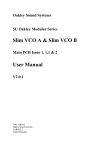
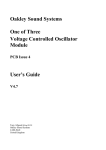
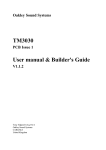

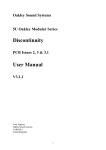

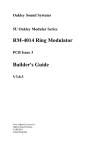

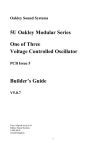
![Manual condicionador de sinal SD20 [PTBR]](http://vs1.manualzilla.com/store/data/006085115_1-891da68fb4d8bbd4bc5f0d8350060514-150x150.png)

